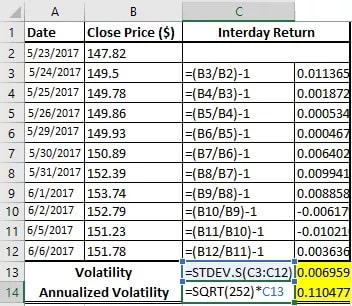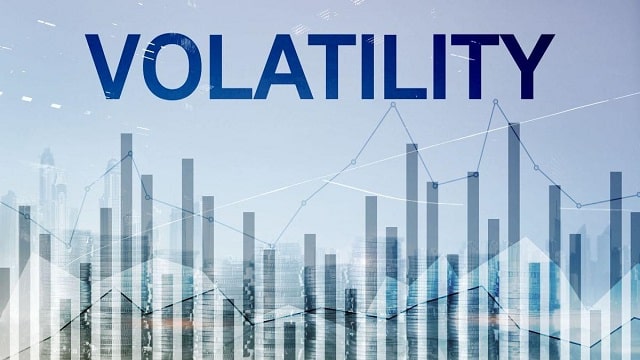What is volatility?
Volatility is a financial term that refers to the variation in the price of an asset over time. An asset is considered volatile when its price changes rapidly and significantly in a short period of time.
Volatility: A Simple Explanation
Put another way, volatility indicates how much and how quickly an asset’s prices change.
It is commonly used in finance to assess investment risk. An asset with high volatility has prices that fluctuate widely and rapidly, which can mean greater opportunities for profit, but also greater risks of loss. On the other hand, assets with low volatility are more stable and predictable, attracting more conservative investors.
For example, if one day a kilo of apples costs $5, the next day $15, and the next day $10, the price of apples in this market is very volatile. If, on the other hand, a price is very stable and hardly varies, it is said to be a low-volatile price.
Various indicators are used to measure volatility, one of the most common being standard deviation, which assesses how much prices deviate from their historical average.
It is crucial to remember that volatility measures the past performance of an asset and not its future performance, although historical patterns often continue.
There are indicators that attempt to predict future volatility, such as the VIX index in the United States, which estimates the expected volatility in financial markets.
Types of volatility
We can classify it into the following types:
- Historical volatility: This refers to the variations that it presents with respect to its average over a period of time. For example, using the Spanish Ibex 35 over a 10-year period, we can see how it has behaved taking into account the average of that series.
- Implied or market volatility: This is the volatility we estimate the asset will have in the future. Therefore, it indicates the market expectations or the implicit value that the asset would have, taking into account the factors that affect its price. Let’s imagine that we have shares in a company and we expect its volatility to increase in the future and for the price to rise.
- Deterministic volatility: The variation in profitability has a clear pattern over time or it does not vary. We can use the standard deviation to make predictions. For example, an asset with constant profitability.
- Stochastic volatility: In this case, volatility does not follow any pattern over that period of time. Therefore, we cannot predict what will happen and we must consider stochastic or similar models to be able to predict, to a certain extent. This is the most common, hence the difficulty in making future predictions.
How to calculate volatility
Sample Calculation
You want to find out the volatility of the stock of ABC Corp. for the past four days. The stock prices are given below:
- Day 1 – $10
- Day 2 – $12
- Day 3 – $9
- Day 4 – $14
To calculate the volatility of the prices, we need to:
- Find the average price:
$10 + $12 + $9 + $14 / 4 = $11.25 - Calculate the difference between each price and the average price:
Day 1: 10 – 11.25 = -1.25
Day 2: 12 – 11.25 = 0.75
Day 3: 9 – 11.25 = -2.25
Day 4: 14 – 11.25 = 2.75 - Square the difference from the previous step:
Day 1: (-1.25)2 = 1.56
Day 2: (0.75)2 = 0.56
Day 3: (-2.25)2 = 5.06
Day 4: (2.75)2 = 7.56
- Sum the squared differences:
1.56 + 0.56 + 5.06 + 7.56 = 14.75 - Find the variance:
Variance = 14.75 / 4 = 3.69 - Find the standard deviation:
Standard deviation = 1.92 (square root of 3.69)
The standard deviation indicates that the stock price of ABC Corp. usually deviates from its average stock price by $1.92.
(Example Credit: https://corporatefinanceinstitute.com/resources/career-map/sell-side/capital-markets/volatility-vol/)
Investment volatility
Volatility is a concept that is widely used in the financial field. Volatility shows how the price of an asset varies from its historical average. For this reason, standard deviation is used as an indicator of volatility.
In investment funds, the volatility of fund returns is also measured, which gives us a good view of the fund’s volatility and its risk.
Volatility is a determining factor when it comes to setting up an investment portfolio, as it is linked to risk. Therefore, it is important for an investor to be clear about his or her investment profile in order to know which assets to invest in.
I leave you this related content here in case you want to know what your investment profile is: Investment profile course.
Difference between volatility and risk
It is very important not to confuse volatility and risk. That is, volatility measures the variation in prices with respect to their average, which is part of the risk, but it is not the only risk there is. There are assets that are not very volatile and they are very risky, because the company can go bankrupt.
Although generally, the more volatile an asset is, the more risky it is, this is not always the case.
Volatility is often used as a synonym for risk because it can be a good indicator of risk, i.e. people with a higher risk aversion will prefer less volatile assets. However, there are financial products that are quite volatile but have little risk, and vice versa.
For example, gold is one of the safest assets in the world, but its price is quite volatile. On the other hand, there are other products, such as short-term high-yield bonds, which may be less volatile than gold, but which are much riskier, because the company can go bankrupt and the investor can lose the money invested.
Volatility in the market
There are many indicators to measure market volatility. One of the most widely used in the world is the VIX index, which uses a weighted portfolio of call options and put options on the American S&P 500 index (SPX).
The VIX is the world’s most famous volatility index, but there are also volatility indices. In Europe, the VSTOXX index comprises the implied volatility of options on the EURO STOXX 50 index, which refers to the 50 largest publicly traded European companies. For the NASDAQ 100 there is the VXN index, for the Russell 2000 there is the RVX index and for the DOW JONES there is the VXD index.
The VIX index is very useful for determining market sentiment. That is, if its level is high, it indicates that there is fear and pessimism in the market.
In investment funds
As we mentioned above, in investment funds, the standard deviation is also used to measure the volatility of the fund’s returns, which gives us a good view of the fund’s volatility and its risk.
Thus, a high standard deviation means that returns have experienced strong variations, while a low standard deviation indicates that these returns have been much more stable over time.
The larger the standard deviation, the greater the potential loss for the investor and, consequently, the greater his risk.
Let’s look at a simple practical example of the returns of two investment funds from the famous fund manager Bestinver:
It can be said then, by comparing the historical returns of both investment funds, that the Bestinfond fund has a lower volatility than that of Bestinver Internacional. This means that the performance of the returns of Bestinfond has fluctuated closer to its historical average, that is, the values on average have deviated less than the other fund that has a higher volatility.
But volatility alone does not provide much information to investors. What does it mean, for example, if a fund has an annual volatility of 20%?
Hence the importance of comparing the fund’s volatility with the average of its category and the averages of the categories among themselves. In addition, as we mentioned at the beginning, volatility measures past performance, so it does not have to behave in the same way in the future.
How to calculate volatility in Excel
Step 1: Time Frame
Volatility is a time frame measurement, meaning it measures the price fluctuations of an asset or security over a certain period of time. Different time periods will be more appropriate depending on what type of trader you are. For example, a day trader may only care about weekly volatility, while a swing trader may care about monthly volatility. For the purposes of this article, a time frame of 10 days will be used in the example.
Step 2: Enter Pricing Information
After you determine your time frame, the next step is to enter all of the stock’s closing prices for that time frame into cells B2 to B12 in sequential order, with the most recent price at the bottom. (Note that if you are working with a ten-day time frame, you will need eleven days of data to calculate the return for a 10-day period.)
Step 3: Calculate Returns
In column C, calculate the interday return by dividing each price by the previous day’s closing price and subtracting one. For example, if McDonald’s (MCD) closed at $147.82 on the first day and $149.50 on the second day, the second day’s return would be (149.50/147.82) – 1, or 0.011, indicating that the price on the second day was 1.1% higher than the price on the first day.
Step 4: Calculate Standard Deviation
Volatility is naturally related to variance and, by extension, standard deviation, or the degree to which prices vary from their average. In cell C13, enter the formula “=STDEV.S(C3:C12)” to calculate the standard deviation for the period.
Step 5: Annualize the period’s volatility
Historical volatility is usually converted to an annualized figure, so to convert the daily standard deviation calculated above into a useful metric, it must be multiplied by an annualization factor based on the period used. The annualization factor is the square root of the number of periods present in a year.
The following table shows McDonald’s volatility over a 10-day period:

The above example used daily closing prices and there are 250 to 252 trading days per year. Therefore, in cell C14, enter the formula “=SQRT(252)*C13” to convert the standard deviation of this ten day period into annualized historical volatility.
Key points
- It is essential to assess the risk of an investment since a more volatile asset can offer greater returns but also greater risks.
- It is usually measured by standard deviation, which calculates how much prices deviate from their historical average.
- There are several types of volatility, including historical, implied, deterministic, and stochastic.

